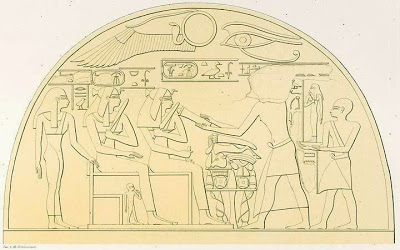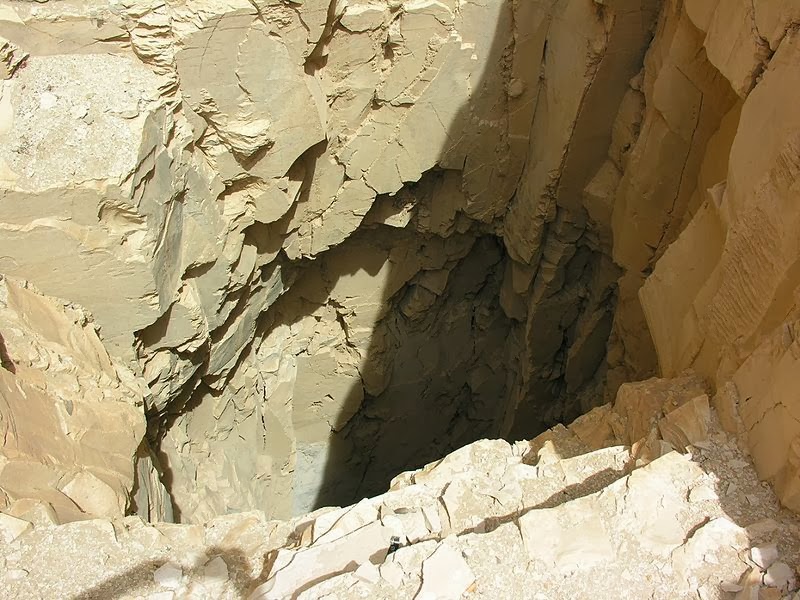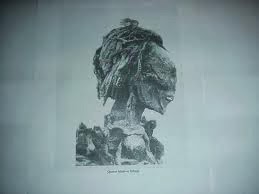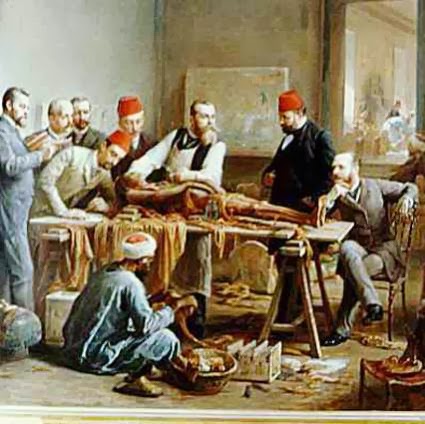Egypt

In the cliffs which hang above the temple of Hatshepsut at Deir el Bahri lay a most ingenious tomb that may have belonged to one of the XVII Dynasty king's wives Inhapi. The kings wife had been buried away from the family necropolis of Dra Abu el Naga perhaps because of her status as secondary wife, though Inhapi did produce a child for her husband King Sequenenre II, a daughter named Henttimehu.(2)
The mummy of Henttimehu is that of an old woman who would have died many decades after her mothers burial, yet there is a possibility that her mothers tomb was opened and Henttimehu added sometime around 1600 BC, so she may join her mother in her "mansion of eternity", as she was present with her when found in 1881.
The evidence for Inhapi's tomb exists in three inscriptions on the coffins of the first three king's of Dynasty XIX, and the mummy of a woman found in Theban Tomb 320 with them inscribed with the name of Inhapi on her shroud. The three inscriptions are all dated to year 10, 4 prt, 17, and mention the king's are on their way to the "High place of Inhapi" in which that Amenophis I is already present. Two of the three inscriptions, those of Seti I and Ramesses II are followed by another inscription which tells that three days later they had arrived, but in both cases the tomb of Inhapi is now referred to as the "Mansion of Eternity", with again a mention of Amenophis I's presence.
The evidence that the tomb TT320 where the mummy of the Kings Wife Inhapi, the three XIX Dynasty king's and Amenophis I were found in 1881 is Inhapi's tomb is presented.

An inscription found at the bottom of the well of TT320 tells about the burial of the High Priest Pinudgem II on the same date as mentioned on the coffins of Seti I and Ramesses II, as entering the mansion of eternity where Amenophis I already was. The connection of dates is anything but coincidence with the potential scale of the operations taking place on that day would negate to me the possibility of coincidence just too much to accomplish including the high priests burial and the potential transfer of thousands of objects and dozens of coffins that each would have required at least 6 to ten men to maneuver the heavy cases to the tomb and in place within.
We can be assured that by the time the XIX Dynasty king's entered the tomb everything, including the mummy of King Amenophis I, and all of the XXI Dynasty mummies found in the end chamber were in place. Seti's coffin was brought in and now blocked the bend in the first corridor of the tomb, no one else could have gone beyond its massive bulk, ending the ancient journey of Ramesses I, and his immediate successors around 850 B.C., about 800 years after Inhapi's burial.
It is here that the emergency excavation of the tomb clouds the issue as when the tomb was opened a XVII Dynasty coffin was found in the first corridor second from the door. Gaston Maspero, the head of Egypt's antiquities service and national museum in 1881 recorded in his publications that the second coffin from the door in the entrance corridor was of XVII Dynasty appearance but does not clarify who's coffin it was. In one case he said it was the coffin containing the mummy of Inhapi but in later print appears to have reversed his position that it was just a coffin of that date.

Wherever Inhapi's mummy was positioned in the tomb would have been second hand knowledge to Mr. Maspero as he was in Paris at the time of discovery. Leaving the find to be investigated and excavated by Emile Brugsh on behalf of the antiquities service. The tomb contained only two coffins of XVII Dynasty appearance among dozens of coffins within the cache and one would expect that the coffin containing Inhapi would be back in the burial chamber if the tomb TT320 was the high place mentioned on the coffins of the king's.
It must be remembered that the coffins were seen in the dark before being wrapped in sail cloth for their journey to the museums steamer and on to the museum where removed of their sail cloth coverings the coffins could be examined more closely. That is to say this of the operation, the excitement of the find combined with the lack of notes and photographs of the in-situ material makes Mr. Brugsh's words an amusing story but little more.
That if the head of the Egyptian antiquities authority of the time Gaston Maspreo was unsure as to the occupant of the coffin second from the tombs entrance, that likely means that Emile Brugsh himself was probably confused of this coffins occupant, and it may well be that King Sequenere II, was in that coffin, and that the coffin of Rai which contained the mummy of Inhapi was actually found back in her burial chamber?
Inevitably the museums finder Emile Brugsh would remember who was first at the door and where King Seti I, was, as his enormous coffin blocked the bend in the entrance corridor but after going past the Thutmoside king's confusion and the job ahead might well have overwhelmed Mr. Brugsh observations as I would expect of anyone conducting this excavation in a couple of days.

The Ancient Egyptian priestly class was occupied with some of histories most superstitious smoke reading dream interpreters.
To officials who conducted these operations in the tomb in ancient times there would have been no spare of magic spells to which the Egyptians were some of histories biggest purveyors of, and that within this physical salvation came spiritual considerations to be taken to best accommodate the tombs occupants civility and to the workers of the operations own spiritual well being. Within this vein the mummy of Inhapi may have played a bigger part in the re-internment activities within the tomb in ancient times than is normally granted.
On his outer coffin in the Egyptian Museum in Turin, Butehamun has the titles of "Opener of the gates in the necropolis", "Opener of the gates of the underworld" and "Overseer of works in the house of eternity". He is also shown in a vignette on the coffin in adoration of a number of king's and queen's including Amenophis I, Ahhotep, Ahmose-Nofretari, Sitamun, Meryetamun and Prince Sipair and as it happens all were found in tomb TT320 (4), and all had likely come from that families burial ground at Dra Abu el Naga.,
Butehamun's name also appears on the bandages wrapping the mummy of King Ramesses III who was also found in the tomb still containing golden scarabs overlooked or left by Butehamun and his workers on the murdered kings mummy, and again Butehamun's name appears in the inscription of the burial of Pinudgem II at the bottom of the tombs shaft.
As the restoration parties were restoring tombs around the necropolis' Butehamun would have been very susceptible to any of his royal charges that should appear to him in his dreams or omens he witnessed. Butehamun in his job would likely be open to any instructions those persons may have communicated to him while he slept, whether he had restored the burials or lightened the royal mummies of their amulets.
Most people on occasion bring home their work in thoughts and dreams and which in our modern society is little interested but the ancient Egyptians were consciously searching dreams for omens. Butehamun probably took his job with piety and conscious that he did not want the spirits of those he was reburying bothering him. Butehamun was proud of his job and put his name in many places in the operations he oversaw in the tomb.
Inscriptions on the shroud of Ramesses IX, tells that the kings mummy was removed from his tomb in the Valley of the Kings and taken to the temple of Medinet Habu for restoration.(1) Be it that the "High place of Inhapi" was in good order when found by the priests in ancient times they may have removed her mummy and equipment whole to the temple to be unwrapped and lightened of her jewels in a temple surrounding while her tomb was being altered for a mass burial of notables.
The last docket on the coffins of Seti I and Ramesses II tell of arriving at the "Mansion of Eternity" three days later. It would not be unreasonable for the burial party to have changed course during the three days journey from the tomb of Seti I in the Valley of the Kings to Deir el Bahri tomb 320.
All three coffins of the king's related to Seti I say in the five dockets of journey and arrival to the tomb that Amenophis I is already present, which for me makes it less likely that Amenophis I was also moved ahead of these three kings to the new tomb. I have always felt the unrelated very large male mummy found at the entrance of TT320, in the coffin of Nebseni may well be at this position as a bodyguard honored to guard the tomb with the reintroducing of Queen Inhapi to the front behind the bodyguard as her place in the tomb.
The Overseer of works in the house of eternity Butehamun may have realized the need for the lady of the house to take her place as hostess and rightful claimant at the door of TT320, as it is her "Mansion of Eternity", and everyone else no matter how great was a guest of hers.
Except, the principle of Occam's razor, that the fewest assumptions is the best answer, would mean that it was King Sequenenre's coffin in the entrance corridor leaving the lady of the house in the burial chamber!
Notes:
(1) Dockets: The Theban Royal Mummy Project
(2) Stela of Hentimehu and Ahmose Inhapi
(3) The Royal Mummies, G. Elliot Smith, ISBN 071562959 X
(4) The Complete Valley of the Kings, Nicholas Reeves & Richard H. Wilkinson, ISBN: 978-0-500-2840-3-2, Pg. 205
(5) Entrance to TT320: Keith Hazell
(5) Mummy of Inhapi: E.G. Smith, Catalogue General Antiquites Egyptiennes du Musee du Caire: The Royal Mummies, Cairo, 1912; The University of Chicago Library
- Tuesday's Egyptian
The Eye of Re on the Mummy of Pharaoh Seti I By the time Pharaoh Seti I was buried in 1279 BC he had restored Egypt to the former glory lost during the Amarna period of a half century earlier. Seti left as tribute to his reign temples such as at Abydos...
- Unwrapping A Mummy
John H. Taylor University of Texas Press Austin 1996 ISBN: 0-292-78141-5 In the winter of 1904-05 Edouard Naville on behalf of the Egypt Exploration Fund was excavating the Eleventh Dynasty temple of King Mentuhotep II against the limestone cliffs of...
- Wv 22?
I have noticed on a number of sites that one of the mummies recently studied by Dr. Hawass has been given the designation of WV 22. The mummy in question was found in the Valley of kings in KV 35 in a side chamber with an inscription identifying it as...
- To The Great Lord Granted Eternal Life
With the arrival of the great cache of Dier el Bahari to the Boulaq museum in 1881 the directors found themselves in the presence of eleven kings of Dynasties 17 -21, ca. 1650 - 945 bce. Also accompanying the kings were seven queens and a number of prince's,...
- The Great Missing
There is little doubt of three caches of kings from the end of the New Kingdom yet one cache is clearly missing and perhaps today represented only by its absence. The great cache of 1881 found a prince named Ahmosis though sadly he is not the liberator...
Egypt
The Lady of the House

"The day of bringing King Usermaatre-Septenre, the great god out of this tomb of King Menmaatre- Setymer(en)ptah that he might be taken into this high place of Inhapi which is a great place","and in which Amenophis rests" (1)
THE HIGH PLACE OF INHAPI
The mummy of Henttimehu is that of an old woman who would have died many decades after her mothers burial, yet there is a possibility that her mothers tomb was opened and Henttimehu added sometime around 1600 BC, so she may join her mother in her "mansion of eternity", as she was present with her when found in 1881.
The evidence for Inhapi's tomb exists in three inscriptions on the coffins of the first three king's of Dynasty XIX, and the mummy of a woman found in Theban Tomb 320 with them inscribed with the name of Inhapi on her shroud. The three inscriptions are all dated to year 10, 4 prt, 17, and mention the king's are on their way to the "High place of Inhapi" in which that Amenophis I is already present. Two of the three inscriptions, those of Seti I and Ramesses II are followed by another inscription which tells that three days later they had arrived, but in both cases the tomb of Inhapi is now referred to as the "Mansion of Eternity", with again a mention of Amenophis I's presence.
The evidence that the tomb TT320 where the mummy of the Kings Wife Inhapi, the three XIX Dynasty king's and Amenophis I were found in 1881 is Inhapi's tomb is presented.

An inscription found at the bottom of the well of TT320 tells about the burial of the High Priest Pinudgem II on the same date as mentioned on the coffins of Seti I and Ramesses II, as entering the mansion of eternity where Amenophis I already was. The connection of dates is anything but coincidence with the potential scale of the operations taking place on that day would negate to me the possibility of coincidence just too much to accomplish including the high priests burial and the potential transfer of thousands of objects and dozens of coffins that each would have required at least 6 to ten men to maneuver the heavy cases to the tomb and in place within.
We can be assured that by the time the XIX Dynasty king's entered the tomb everything, including the mummy of King Amenophis I, and all of the XXI Dynasty mummies found in the end chamber were in place. Seti's coffin was brought in and now blocked the bend in the first corridor of the tomb, no one else could have gone beyond its massive bulk, ending the ancient journey of Ramesses I, and his immediate successors around 850 B.C., about 800 years after Inhapi's burial.
It is here that the emergency excavation of the tomb clouds the issue as when the tomb was opened a XVII Dynasty coffin was found in the first corridor second from the door. Gaston Maspero, the head of Egypt's antiquities service and national museum in 1881 recorded in his publications that the second coffin from the door in the entrance corridor was of XVII Dynasty appearance but does not clarify who's coffin it was. In one case he said it was the coffin containing the mummy of Inhapi but in later print appears to have reversed his position that it was just a coffin of that date.

Wherever Inhapi's mummy was positioned in the tomb would have been second hand knowledge to Mr. Maspero as he was in Paris at the time of discovery. Leaving the find to be investigated and excavated by Emile Brugsh on behalf of the antiquities service. The tomb contained only two coffins of XVII Dynasty appearance among dozens of coffins within the cache and one would expect that the coffin containing Inhapi would be back in the burial chamber if the tomb TT320 was the high place mentioned on the coffins of the king's.
It must be remembered that the coffins were seen in the dark before being wrapped in sail cloth for their journey to the museums steamer and on to the museum where removed of their sail cloth coverings the coffins could be examined more closely. That is to say this of the operation, the excitement of the find combined with the lack of notes and photographs of the in-situ material makes Mr. Brugsh's words an amusing story but little more.
That if the head of the Egyptian antiquities authority of the time Gaston Maspreo was unsure as to the occupant of the coffin second from the tombs entrance, that likely means that Emile Brugsh himself was probably confused of this coffins occupant, and it may well be that King Sequenere II, was in that coffin, and that the coffin of Rai which contained the mummy of Inhapi was actually found back in her burial chamber?
Inevitably the museums finder Emile Brugsh would remember who was first at the door and where King Seti I, was, as his enormous coffin blocked the bend in the entrance corridor but after going past the Thutmoside king's confusion and the job ahead might well have overwhelmed Mr. Brugsh observations as I would expect of anyone conducting this excavation in a couple of days.

The Ancient Egyptian priestly class was occupied with some of histories most superstitious smoke reading dream interpreters.
To officials who conducted these operations in the tomb in ancient times there would have been no spare of magic spells to which the Egyptians were some of histories biggest purveyors of, and that within this physical salvation came spiritual considerations to be taken to best accommodate the tombs occupants civility and to the workers of the operations own spiritual well being. Within this vein the mummy of Inhapi may have played a bigger part in the re-internment activities within the tomb in ancient times than is normally granted.
On his outer coffin in the Egyptian Museum in Turin, Butehamun has the titles of "Opener of the gates in the necropolis", "Opener of the gates of the underworld" and "Overseer of works in the house of eternity". He is also shown in a vignette on the coffin in adoration of a number of king's and queen's including Amenophis I, Ahhotep, Ahmose-Nofretari, Sitamun, Meryetamun and Prince Sipair and as it happens all were found in tomb TT320 (4), and all had likely come from that families burial ground at Dra Abu el Naga.,
Butehamun's name also appears on the bandages wrapping the mummy of King Ramesses III who was also found in the tomb still containing golden scarabs overlooked or left by Butehamun and his workers on the murdered kings mummy, and again Butehamun's name appears in the inscription of the burial of Pinudgem II at the bottom of the tombs shaft.
As the restoration parties were restoring tombs around the necropolis' Butehamun would have been very susceptible to any of his royal charges that should appear to him in his dreams or omens he witnessed. Butehamun in his job would likely be open to any instructions those persons may have communicated to him while he slept, whether he had restored the burials or lightened the royal mummies of their amulets.
Most people on occasion bring home their work in thoughts and dreams and which in our modern society is little interested but the ancient Egyptians were consciously searching dreams for omens. Butehamun probably took his job with piety and conscious that he did not want the spirits of those he was reburying bothering him. Butehamun was proud of his job and put his name in many places in the operations he oversaw in the tomb.
Inscriptions on the shroud of Ramesses IX, tells that the kings mummy was removed from his tomb in the Valley of the Kings and taken to the temple of Medinet Habu for restoration.(1) Be it that the "High place of Inhapi" was in good order when found by the priests in ancient times they may have removed her mummy and equipment whole to the temple to be unwrapped and lightened of her jewels in a temple surrounding while her tomb was being altered for a mass burial of notables.
The last docket on the coffins of Seti I and Ramesses II tell of arriving at the "Mansion of Eternity" three days later. It would not be unreasonable for the burial party to have changed course during the three days journey from the tomb of Seti I in the Valley of the Kings to Deir el Bahri tomb 320.
All three coffins of the king's related to Seti I say in the five dockets of journey and arrival to the tomb that Amenophis I is already present, which for me makes it less likely that Amenophis I was also moved ahead of these three kings to the new tomb. I have always felt the unrelated very large male mummy found at the entrance of TT320, in the coffin of Nebseni may well be at this position as a bodyguard honored to guard the tomb with the reintroducing of Queen Inhapi to the front behind the bodyguard as her place in the tomb.
The Overseer of works in the house of eternity Butehamun may have realized the need for the lady of the house to take her place as hostess and rightful claimant at the door of TT320, as it is her "Mansion of Eternity", and everyone else no matter how great was a guest of hers.
Except, the principle of Occam's razor, that the fewest assumptions is the best answer, would mean that it was King Sequenenre's coffin in the entrance corridor leaving the lady of the house in the burial chamber!
Notes:
(1) Dockets: The Theban Royal Mummy Project
(2) Stela of Hentimehu and Ahmose Inhapi
(3) The Royal Mummies, G. Elliot Smith, ISBN 071562959 X
(4) The Complete Valley of the Kings, Nicholas Reeves & Richard H. Wilkinson, ISBN: 978-0-500-2840-3-2, Pg. 205
(5) Entrance to TT320: Keith Hazell
(5) Mummy of Inhapi: E.G. Smith, Catalogue General Antiquites Egyptiennes du Musee du Caire: The Royal Mummies, Cairo, 1912; The University of Chicago Library
- Tuesday's Egyptian
The Eye of Re on the Mummy of Pharaoh Seti I By the time Pharaoh Seti I was buried in 1279 BC he had restored Egypt to the former glory lost during the Amarna period of a half century earlier. Seti left as tribute to his reign temples such as at Abydos...
- Unwrapping A Mummy
John H. Taylor University of Texas Press Austin 1996 ISBN: 0-292-78141-5 In the winter of 1904-05 Edouard Naville on behalf of the Egypt Exploration Fund was excavating the Eleventh Dynasty temple of King Mentuhotep II against the limestone cliffs of...
- Wv 22?
I have noticed on a number of sites that one of the mummies recently studied by Dr. Hawass has been given the designation of WV 22. The mummy in question was found in the Valley of kings in KV 35 in a side chamber with an inscription identifying it as...
- To The Great Lord Granted Eternal Life
With the arrival of the great cache of Dier el Bahari to the Boulaq museum in 1881 the directors found themselves in the presence of eleven kings of Dynasties 17 -21, ca. 1650 - 945 bce. Also accompanying the kings were seven queens and a number of prince's,...
- The Great Missing
There is little doubt of three caches of kings from the end of the New Kingdom yet one cache is clearly missing and perhaps today represented only by its absence. The great cache of 1881 found a prince named Ahmosis though sadly he is not the liberator...
